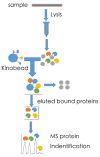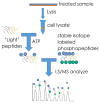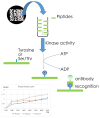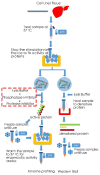Drug Discovery in Liver Disease Using Kinome Profiling
- PMID: 33807722
- PMCID: PMC7961955
- DOI: 10.3390/ijms22052623
Drug Discovery in Liver Disease Using Kinome Profiling
Abstract
The liver is one of the most important organs, playing critical roles in maintaining biochemical homeostasis. Accordingly, disease of the liver is often debilitating and responsible for untold human misery. As biochemical nexus, with kinases being master regulators of cellular biochemistry, targeting kinase enzymes is an obvious avenue for treating liver disease. Development of such therapy, however, is hampered by the technical difficulty of obtaining comprehensive insight into hepatic kinase activity, a problem further compounded by the often unique aspects of hepatic kinase activities, which makes extrapolations from other systems difficult. This consideration prompted us to review the current state of the art with respect to kinome profiling approaches towards the hepatic kinome. We observe that currently four different approaches are available, all showing significant promise. Hence we postulate that insight into the hepatic kinome will quickly increase, leading to rational kinase-targeted therapy for different liver diseases.
Keywords: hepatitis; hepatocellular carcinoma; hepatocytes; kinases; kinome; liver; peptide arrays.
Conflict of interest statement
The authors declare no conflict of interest.
Figures







Similar articles
-
Systems medicine approaches for peptide array-based protein kinase profiling: progress and prospects.Expert Rev Proteomics. 2016 Jun;13(6):571-8. doi: 10.1080/14789450.2016.1187564. Epub 2016 May 31. Expert Rev Proteomics. 2016. PMID: 27241729 Review.
-
Technological advances for interrogating the human kinome.Biochem Soc Trans. 2017 Feb 8;45(1):65-77. doi: 10.1042/BST20160163. Biochem Soc Trans. 2017. PMID: 28202660 Review.
-
The dynamic nature of the kinome.Biochem J. 2013 Feb 15;450(1):1-8. doi: 10.1042/BJ20121456. Biochem J. 2013. PMID: 23343193 Free PMC article. Review.
-
Large-scale proteomics analysis of the human kinome.Mol Cell Proteomics. 2009 Jul;8(7):1751-64. doi: 10.1074/mcp.M800588-MCP200. Epub 2009 Apr 15. Mol Cell Proteomics. 2009. PMID: 19369195 Free PMC article.
-
Targeting the human kinome for cancer therapy: current perspectives.Crit Rev Oncog. 2012;17(2):233-46. doi: 10.1615/critrevoncog.v17.i2.70. Crit Rev Oncog. 2012. PMID: 22471710 Review.
Cited by
-
Recent Advances in Kinase Drug Discovery Part I: The Editors' Take.Int J Mol Sci. 2021 Jul 15;22(14):7560. doi: 10.3390/ijms22147560. Int J Mol Sci. 2021. PMID: 34299180 Free PMC article.
-
Rosa26-LSL-dCas9-VPR: a versatile mouse model for tissue specific and simultaneous activation of multiple genes for drug discovery.Sci Rep. 2022 Nov 10;12(1):19268. doi: 10.1038/s41598-022-23127-7. Sci Rep. 2022. PMID: 36357523 Free PMC article.
References
-
- Hall J.E. Pocket Companion to Guyton & Hall Textbook of Medical Physiology E-Book. Elsevier Health Sciences; Amsterdam, The Netherlands: 2015.
Publication types
MeSH terms
Substances
LinkOut - more resources
Full Text Sources
Other Literature Sources
Medical
Research Materials

